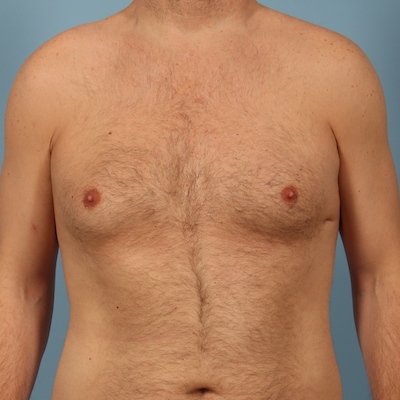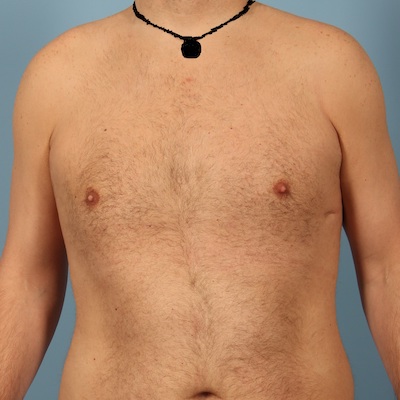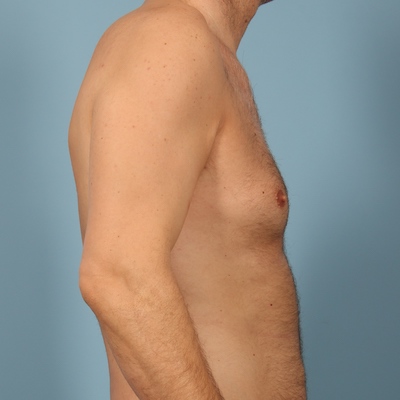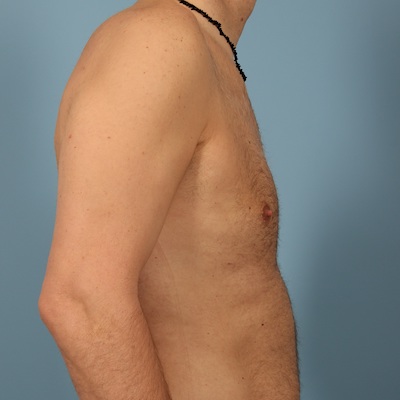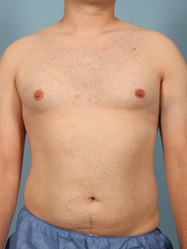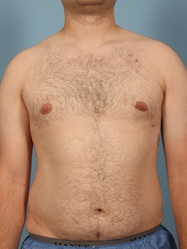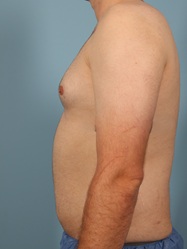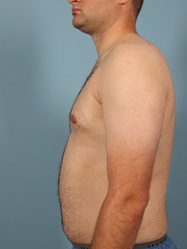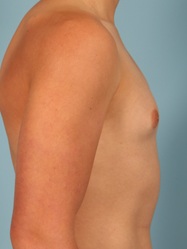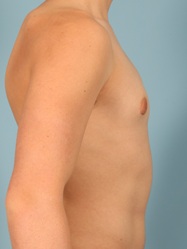Main Content

Gynecomastia (Male Breast) Surgery
If you’d like to get rid of oversized male breasts, visit Monarch Plastic Surgery and Skin Renewal Center for gynecomastia surgery. Also called male breast reduction, this procedure restores a more traditionally masculine chest.
At Monarch, experienced plastic surgeons Dr. Carmen Kavali and Dr. Teri N. Moak frequently help men address gynecomastia (often called “man boobs”). Schedule your consultation today at our Sandy Springs clinic. We’re not far from the Jimmy Carter Presidential Library and Museum, along with coffee shops like Just Love Coffee Cafe, Bagel Boys Café, and Zambawango.
Questions & Answers
Gynecomastia surgery involves removal of excess male breast tissue. This procedure is often combined with liposuction to help achieve the best chest contour possible. Excess drooping skin may also be removed, and the areolae may be resized and/or repositioned when required.
There are many decisions that need to be made when considering gynecomastia surgery, and your surgeon will discuss these in detail with you after she examines you.
Gynecomastia is a common condition in men that results in enlarged male breast tissue. It can be seen in men of all ages but usually occurs during puberty or older adulthood. Gynecomastia typically involves male breast tissue growth that can be seen just below the nipple and is felt as a breast lump in the area. It may be tender to the touch, and it may be present in one or both breasts.
Gynecomastia can occur as a result of imbalances in testosterone and estrogen, so it is important to make sure that these underlying hormonal causes are explored and treated, if necessary. It can also be caused by obesity or certain medications. Other more serious causes of gynecomastia include diseases of the adrenal glands, pituitary glands, or other organs, so your surgeon will make sure to screen you for any of these causes.
In some men, gynecomastia will resolve on its own without treatment, usually over the course of 1-2 years. However, in some cases, this breast tissue persists into teenage years and adulthood and can be a source of self-consciousness or discomfort. If you have developed more breast tissue than you would like, gynecomastia surgery may be helpful for you.
The benefits of gynecomastia surgery are unique to each individual. Benefits of gynecomastia surgery may include:
- Boosting your self-esteem
- Improving chest definition
- Improving your self-confidence at the beach or in certain types of clothing
- Gaining a more masculine appearance
- Correcting mild asymmetry
While gynecomastia surgery can address a variety of concerns, it does have limitations. It is important to know these limitations. Gynecomastia surgery cannot:
- Increase muscle volume of the chest
- Permanently address gynecomastia in all cases (certain factors may cause it to recur)
If you’re ready to get a male breast reduction and restore the appearance of your chest, the next step is choosing the right plastic surgeon for the job. There are a lot of providers out there, and it can be difficult to pick between them.
Sandy Springs, Buckhead, and Atlanta patients choose Monarch Plastic Surgery and Skin Renewal Center time and time again for their procedures. At Monarch, our plastic surgeons have the precision, skill, and experience required to create very natural-looking gynecomastia surgery results.
Award-winning board-certified plastic surgeon Dr. Carmen Kavali has been named a Top Doctor by both Atlanta Magazine and The Atlantan magazine. The Consumers’ Research Council of America has recognized her as one of America’s Top Plastic Surgeons for years. Castle Connolly has recognized her as an Exceptional Woman in Medicine since 2020 and a Top Doctor by Castle Connolly since 2017.
She went to medical school at Macon, GA’s Mercer University, and after graduating, she followed this with a general surgery residency at the University of Illinois. To further supplement her vast surgical knowledge, she then completed a specialized plastic surgery fellowship at Wayne State University in Detroit, MI.
Dr. Kavali has given lectures and presentations at medical conferences and has shared her knowledge as a medical expert on podcasts, on radio shows, and in magazines. She has also written numerous medical journal articles.
She is a member of medical associations like the American Society of Plastic Surgeons, the Medical Association of Atlanta, the Medical Association of Georgia, the American Society for Laser Medicine and Surgery, and the Atlanta Women’s Medical Alliance.
Board-eligible aesthetic plastic surgeon Dr. Teri N. Moak has authored award-winning articles for medical publications, along with numerous manuscripts and medical textbook chapters. She has been invited to medical conferences to deliver presentations and lectures.
Dr. Moak graduated from the University of Mississippi with undergraduate degrees in Biochemistry and Physics, then pursued her Master’s in Biophysical Chemistry. She also received a Master’s in Biological Medical Sciences from Mississippi College. Additionally, she studied Physical Therapy at the University of Mississippi Medical Center.
Next, she earned her MD in Little Rock, AR, at the University of Arkansas for Medical Sciences. After this, she completed her residency in Plastic and Reconstructive Surgery in St. Louis at Washington University. She continued her studies in plastic surgery with Dr. Grady Core, completing a fellowship endorsed by the American Society of Aesthetic Plastic Surgery.
She is a member of a number of medical societies, including the American Society of Plastic Surgeons, the Aesthetic Society, the International Society for Aesthetic Plastic Surgery, and the Medical Association of Georgia.
Both Dr. Moak and Dr. Kavali are on staff at Northside Hospital and Atlanta Outpatient Surgery Center, where they have surgical privileges.
Gynecomastia surgery patients who visit our clinic find the staff to be welcoming, professional, kind, caring, and helpful. Our Sandy Springs clinic is near several excellent restaurants, including Yao Atlanta, The Capital Grille, Fleming’s Prime Steakhouse & Wine Bar, and Louisiana Bistreaux. We’re not far from hotels like the Sheraton Atlanta Perimeter North Hotel, the Crowne Plaza Hotel Atlanta Perimeter at Ravinia, and the Hyatt Place Perimeter Center.
In addition to deciding whether gynecomastia surgery can meet your personal goals, there are several factors to be considered in determining whether you are a good candidate for this surgery. Good candidates for gynecomastia surgery include those who:
- Want to achieve a more normal shape and contour of their chest
- Have addressed any underlying causes of breast tissue development, when applicable
- Have generally good physical and mental health
- Are nonsmokers or are willing to stop smoking before surgery
- Have realistic expectations from gynecomastia surgery
The best way to determine whether you’re a good candidate for gynecomastia surgery is visiting our Atlanta clinic for a consultation with a plastic surgeon. They will be able to tell you whether this procedure is the right match for your needs and goals.
Before your male breast reduction consultation, our patient coordinator will get in touch with you. The patient coordinator will ask questions, give you directions on preparing for the consultation, and answer your questions.
Your gynecomastia surgery consultation will take place at our Sandy Springs clinic. We’re not far from downtown Atlanta, GA, which features attractions like Centennial Olympic Park, The Curb Market, the Georgia Aquarium, and the World of Coca-Cola. Patients often visit the National Center for Civil and Human Rights, The Sun Dial Restaurant, SkyView Atlanta, and galleries like ZuCot Gallery, the MET Atlanta, and the Atlanta Contemporary Art Center.
During the consultation, you’ll meet with a surgeon’s assistant, who will explain more about the details of male breast reduction. They will also ask you questions about your goals, along with questions regarding your medical history. You may be asked about past surgical procedures, allergies, pre-existing health conditions, and supplements or medications you’re currently taking.
You’ll then meet with either Dr. Kavali or Dr. Moak. Your surgeon will perform a thorough physical exam, walk you through the procedure from start to finish, and work with you to create a surgical plan that achieves your goals. Questions are highly encouraged at any time.
The two male breast reduction incision options that our surgeons most commonly perform are the periareolar incision and the periareolar incision combined with an infra-pectoral border incision.
Periareolar: For milder cases of gynecomastia, the incision to remove the breast tissue can be hidden along the bottom half of the border of the areola. This is nearly imperceptible when it heals and is a great option for achieving excellent aesthetic results.
Periareolar combined with infra-pectoral border: For more advanced cases of gynecomastia, more tissue must be removed along with excess skin to achieve an aesthetic chest shape. In these cases, an incision is often required along the border of the areola, in addition to an incision along the bottom part of the pectoralis major (“pushup”) muscle. This incision usually heals well and is hidden in naturally occurring shadows created by the pectoralis muscle.
Many patients wonder if changes are made to the nipples during male breast reduction surgery. This will depend on the severity of the patient’s case.
Nipple areolar complex in good position: For milder cases of gynecomastia, the nipple is in a good position and is flat. In these cases, the nipple does not need to be manipulated.
Nipple areolar complex is low or drooping: For more advanced cases of gynecomastia, the nipple areolar complex is often low or drooping, much like a deflated breast after weight loss or pregnancy in women. In these cases, the nipple must be moved to a higher position on the chest.
This may be accomplished by leaving the nipple attached to some tissue beneath it. In this case, the nipple should retain sensation. However, this method of moving the nipple upward can leave behind some bulk beneath the nipple areolar complex.
An alternative method of addressing a low nipple position is through free nipple grafting. In this case, the nipple is removed from the chest wall and sewn back onto the chest as a skin graft into the desired position. While this eliminates the bulk issue of the prior method, it does cause complete numbness of the nipple, and there is an increased risk of some of the skin not surviving.
Your surgeon will discuss the pros and cons of each of these options as applicable to your case and help you make the right decision for you.
Patients who are undergoing gynecomastia surgery must prepare in several ways, since this can be a major surgical procedure. Following the preparation instructions of Dr. Kavali and Dr. Moak is very important, since proper preparation can greatly minimize the chances of surgical and post-surgical issues.
You won’t be able to shop for the things you need when you’re healing and resting, so you’ll need to prepare beforehand. This means stocking up on any prescribed soaps, ointments, bandages, ice packs, and medications.
Arranging your rest area properly is key. Making your bedroom your recovery area is ideal, especially if it’s near a bathroom, since making your way to the bathroom will feel difficult at first. Your recovery area must have blankets, pillows, towels, bottles of water, snacks, and enough entertainment options to get you through the initial days of the recovery process.
When preparing for your male breast reduction, it will be important to discuss time off with your employer. Being able to take time off is vital, and so you’ll need to arrange for this well in advance.
You’ll also need to arrange for a ride home from the hospital after your gynecomastia surgery. Ask a friend or family member, ideally one who can also stay over and help out for the first night and the following day. You’ll also need assistance with childcare and pet care.
For several weeks before the date of your male breast reduction procedure, you must avoid taking non-steroidal anti-inflammatory drugs (NSAIDs). You must also avoid certain herbal supplements. Avoiding alcohol for a few days before the surgery will also be helpful. NSAIDs, herbal supplements, and alcohol can all exacerbate bruising after the surgery and result in increased bleeding during the surgery.
Smokers will need to quit smoking a number of weeks before the date of their male breast reduction procedure. This is because smoking causes damage to the skin tissues and impairs blood circulation, making healing much more difficult. Smoking can also increase the likelihood of problems during and after surgery.
Gynecomastia surgery is an outpatient procedure performed with general anesthesia in an operating room. The procedure usually takes at least one hour to perform; the exact time will depend on the specifics of each individual case.
Once you’re fully unconscious, your surgeon will create precise incisions as discussed during your surgical consultation. She will then remove excess fat, glandular breast tissue, and/or skin as needed based on the composition of your chest.
Excess fat removal involves liposuction, during which a small incision is created in the chest area. A tool called a cannula is inserted, and then the fat cells are loosened from their surrounding tissues. Medical suction is then used to remove the fat from the body.
Excess glandular breast tissue and skin removal is accomplished through excision with a scalpel. In some cases, a combination of liposuction and excision may be required.
Once all the changes have been accomplished, your surgeon will seal your incisions using medical stitches. She will then dress the sealed incisions appropriately.
After your surgery, you will be placed in dressings and a compression garment. You will spend a short time in the recovery room before a friend or family member takes you home, where you should plan to rest for the remainder of the day.
Be sure to arrange for someone to drive you home after surgery and to stay with you at least the first night. We will advise you on pain medication to ease any discomfort, give you detailed post-operative instructions, and schedule a follow-up appointment to check your progress.
Rest and recovery is vital after you’ve returned home from the procedure. Your body needs time to heal and recover properly, so it’s best to take it easy for a time.
Follow your plastic surgeon’s male breast reduction recovery directions closely during your recovery period. This will help minimize your recovery time, ensure high-quality results, and greatly reduce the risk of post-surgical complications.
It is normal to experience some pain, bruising, and swelling in the first few days after male breast reduction surgery. These issues are temporary and will fade over time.
Wearing the compression garment for four to eight weeks will help control post-surgical swelling and will encourage the skin to better conform to your chest’s new underlying contours. Applying ice packs as directed will reduce swelling and bruising. Pain medication will be prescribed according to our ERAS (Enhance Recovery After Surgery) recovery protocol.
Tiny plastic drains may be inserted into the tissues at the end of gynecomastia surgery. These drains are placed in order to carry excess blood and other fluids out of the area, which prevents formation of hematomas and seromas (collections of blood and other fluids). These must be taken care of properly according to your surgeon’s directions, and they’ll be removed during a follow-up appointment.
Incisions usually heal between 1 and 2 weeks after surgery. Depending on your type of work, you will usually be able to return to work within 1 to 2 weeks. You will have some activity restrictions initially, but most people are able to return to full activity by 6 weeks after surgery.
Light walking is encouraged soon after the operation. However, when it comes to upper-body exercises after gynecomastia surgery, it’s best to avoid them entirely for at least four weeks; chest and arm exercises can strain the incisions and damage the still-healing tissues.
Physically taxing exercises that raise your blood pressure, including strenuous walking and cycling, should be avoided for at least two weeks. Once this time has passed, patients may be able to resume lower-body exercises and cardio, provided they do so carefully.
You’ll need to attend gynecomastia surgery follow-up appointments at our Sandy Springs office, not far from the Hartsfield-Jackson Atlanta Airport. These will ensure that your healing process is going as expected. Your surgeon will examine your incisions, remove stitches, and clear you to resume certain activities. Make sure to bring up any healing-related complications so your surgeon can address them.
The changes made during gynecomastia surgery can be seen immediately. Your chest may require some time to assume a more natural shape. Final results are usually seen at 6 months to a year after surgery.
Every patient’s recovery is different, since every patient’s gynecomastia surgery is tailored to their specific anatomy and goals. Your recovery may be quicker or take more time than average.
The price of male breast reduction varies based on several factors. These can include the specific techniques being performed (liposuction, tissue excision, etc.), anesthesia fees, facility fees, and the amount of time required to perform the operation.
Typically, gynecomastia surgery is not covered by health insurance providers, since it is usually performed for cosmetic reasons. In cases where it’s being performed for functional reasons like pain, mobility problems, soreness, skin irritation, or emotional distress, its cost may be covered by your health insurance provider. Patients may need to prove that their gynecomastia cannot be reversed through non-surgical means.
Patients can also finance their male breast reduction surgery through Alphaeon Credit or CareCredit. These companies provide financing plans, helping patients from all walks of life pay for the cost of their procedures.
To learn more about gynecomastia surgery at Monarch, schedule your personalized consultation by calling (404) 250-3333 or filling out our online contact form. You’ll be able to meet with Dr. Kavali or Dr. Moak at our Sandy Springs office, located near the LEGO Discovery Center, the Fox Theatre, and the Atlanta History Center. We’re not far from midtown Atlanta, home to the Atlanta Botanical Garden in Piedmont Park and the High Museum of Art.
SHOULD I LOSE WEIGHT BEFORE MY MALE BREAST REDUCTION?
Overweight and obese patients are at a greater risk of surgical complications, and because of this, we may potentially recommend losing weight before your male breast reduction surgery. It’s best to be at or near your ideal weight before undergoing this procedure.
If you are planning to lose a significant amount of weight, be sure to tell your surgeon. She may recommend that you stabilize your weight prior to undergoing gynecomastia surgery.
Note that any weight fluctuations after your male breast reduction surgery can potentially affect the appearance of your results. This is another reason why it’s best to already be at or near your ideal weight before your procedure.
HOW CAN I TELL IF I’LL NEED LIPOSUCTION, EXCISION, OR BOTH DURING GYNECOMASTIA SURGERY?
The best way to tell if you’ll need liposuction, excision, or both during gynecomastia surgery is by arranging a consultation with Dr. Moak or Dr. Kavali.
This will allow Dr. Moak or Dr. Kavali to gauge the tissue composition of your enlarged male breasts. Fatty tissue is usually softer to the touch, whereas glandular breast tissue is usually firmer. This is not always the case, however. Because of this, it’s best for the surgeon to evaluate the tissues and make decisions regarding the ideal treatment techniques to perform.
WILL DIETARY CHANGES BE NEEDED DURING GYNECOMASTIA SURGERY RECOVERY?
Though dietary changes aren’t strictly required during gynecomastia surgery recovery, it’s best to eat foods that are rich in nutrients during the healing process. Avoid processed food, dairy products, and sugary desserts whenever possible, and eat lots of lean protein, whole grains, and fresh fruits and vegetables.
Drinking plenty of water is also very important. Staying hydrated reduces the chance of infections and DVTs after surgery, aids in circulation (key for nutrient transport), and encourages cellular repair.
Anesthesia and other medications can increase the risk of dehydration, as can the tissue trauma involved in surgery. To avoid dehydration during recovery, it’s vital to drink lots of water and to stay away from alcohol, coffee, tea, and soda.
IS IT POSSIBLE FOR GYNECOMASTIA TO COME BACK AFTER MALE BREAST REDUCTION SURGERY?
Gynecomastia can come back after male breast reduction surgery, though it is very rare. Fat and glandular breast tissue removed during male breast reduction surgery will not grow back. However, weight gain, hormone-related medical conditions, or use of drugs and alcohol can potentially cause regrowth of male breast tissue after the procedure. Because of this, it’s important to be aware of any lifestyle factors that could contribute to this issue.




